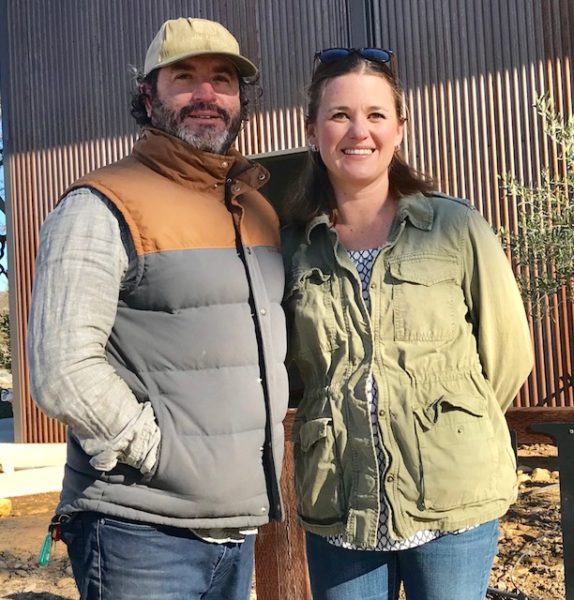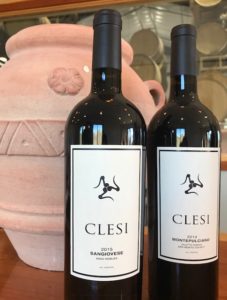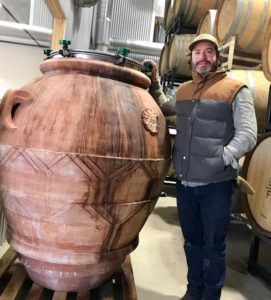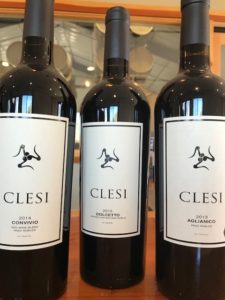Sip and Savor: Clesi’s artisanal Italian wines

Chris and Adrienne Ferrara
Photos by Mira Honeycutt
Winemaker honors his family heritage
– Chris Ferrara is proud of his Sicilian heritage so the veteran vineyard manager and winemaker honors his roots and Italian culture by focusing on producing Italian varietal wines from the Central Coast.
Ferrara’s extensive travels to Italy’s wine regions and his passion for these wines led him to help plant native varieties from Italy’s various regions in and around Paso Robles AVA and San Benito County vineyards, plantings he once managed for winegrowers that now serve as the source for his own label’s fruit.
The dozen wines Ferrara produces at his Clesi winery include montepulciano from Italy’s Abruzzi region along the Adriatic coast, the popular sangiovese from Tuscany and the Sicilian nero d’avola. The southern varieties include aglianico from Campania and negroamaro from Puglia, from the northern Piedmont region comes docletto and nebbiolo.
But Ferrara is quick to point that he’s not mimicking Italian wines.
“I’m growing and producing Italian varieties to reflect where we are — this terroir,” said the winemaker.
Hailing from a long line of farming family, Ferrara paid homage to his great-great grandmother Anna Clesi and named the winery after her along with the symbol of the Sicilian “trinacria” on the bottles . I met Chris and his wife Adrienne at the newly built winery and tasting room in Templeton. They purchased the 30-acre property in 2015, got the permits lined up the following year and opened the tasting room in May 2017. Currently, just five acres are under vine on the property, planted to sangiovese and montepulciano.

Clesi’s sangiovese and montepulciano
Ferrara’s come full circle back to Templeton, where he began working at Wild Horse Winery under legendary winemaker Ken Volk. When the winery changed ownership, much of the staff departed including Ferrara who left in 2006.
Volk encouraged the young winemaker to follow his path and passion. “He said, ‘You can grow so many varieties here.’ We can do more than cabernet.” Since Ferrara gravitated toward Italian varieties, he embarked on his own label Clesi, making his wines in San Luis Obispo until 2015 when the family moved back to Templeton, not far at all from Wild Horse, where he now makes between 3,000-3,500 cases annually.
How does he identify the regions to plant these specific Italian varieties along the Central Coast? I asked.
“Farming is always a gamble,” responded Ferrara. “I take an educated guess where to plant.” For the winemaker, the region is like an artist’s palette — there’s an abundance of different soils plus the options of both cooler and warmer regions. “That’s the beauty of Central Coast,” Ferrara declared.
The winemaker’s educated guess combined with his longtime experience of working with local vineyards has resulted in an excellent portfolio of Clesi’s Italian wines. For example, he commented on the 2014 dolcetto: “I worked a minimum of 20 years on this block near River Road,” in the Paso Robles AVA. The wine glows with a beam of fresh acidity and soft tannins.

Chris Ferrara with the terra cotta amphora in the barrel room
Tasting some other 2014 vintage reds, mostly from Paso Robles AVA, it was clear that the hallmark of Ferrara’s wines is the perfect balance of tannins and acidity, making them superbly food friendly . Pouring the sangiovese, he touched on the similar climate between Paso Robles and Tuscany. However, the difference in the two terroirs is what gives the wines its specific character.
“I love the acids and tannins of this wine” Ferrara commented on the sangiovese. Indeed, the balance of the two is seamless with the harvest time playing a crucial role to get that balance right, he insisted. “Picking decisions play a part in getting the acid and tannin balance,” he said. For sangiovese and aglianico, Ferrara likes to pick them late in October to keep the Brix level low to maintain the wine’s fresh acidity.
Meanwhile, an inky-hued montepulciano showed spice and peppery aromas. Ferrara explained that this grape, not to be confused with vino nobile di montepulciano, a sangiovese clone in Tuscany, is made from a variety grown in the Abruzzi region along Italy’s Adriatic coast. Clesi’s montepulciano is sourced from San Benito’s Siletto Ranch where Ferrara planted the Abruzzi clone on a small two-block lot.
The winemaker is also embarking on producing the little known negroamaro with its first vintage of 2017.

Clesi wines
Ferrara offered a couple of 2017 barrel samples. The aglianico at this young stage showed a good uniformity of tannins and acidity along with a freshness of the fruit. The nero d’avola, which Ferrara farms in Templeton, exuded a heady fragrance. “I’m over the moon,” he said of this Sicilian variety. “These grapes grow so well in Paso.”
Clesi produces only two whites, the greco, which is brilliantly sharp with bracing acidity, and malvasia bianca, fresh and fragrant with jasmine notes. Both wines are ideal with spicy foods or as an aperitif for the hot summer months.
While the majority of Clesi wines are barrel aged in French oak, Ferrara has now added six amphorae, the Italian terra cotta vessels for aging. “Oak barrels add tannins and oak flavor, but terra cotta is a natural way of winemaking and wines are softer and earthier,” he said. Both aglianico and montepulciano are aged 100 percent in amphoraes.
Besides the tasting of an all Italian varietal lineup, there was one that was different — the 2014 Convivio, a cabernet sauvignon-driven Super Tuscan style wine blended with sangiovese and merlot. Well knit, laced with lush tannins and just the right amount of acidity, this is a wine to put away for a few years.
Convivio, which means “shared life,” sums up the Clesi philosophy. It’s a family affair, with Chris and Adrienne pouring their special Italian varietals behind the long red wood slab counter. Besides wine bottles you might find a carton of fresh eggs, which is what we encountered and were offered to take home. The property is home to chickens, pigs and the fresh bounty from the organic garden available in the tasting room during the spring and summer seasons.




















